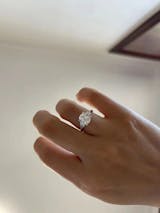HOW TO PICK AN OVAL DIAMOND WITHOUT A BOWTIE
Share

So, you’ve fallen in love with oval-shaped diamonds. Congrats! They’re elegant, elongating (hello, finger-flattering illusion!), and give off major vintage-meets-modern vibes. But wait—before you start picturing yourself flipping your hair like a red-carpet star while admiring your new sparkler, there’s a tiny plot twist you need to know about: the dreaded bowtie effect.
No, it’s not a fancy accessory your diamond secretly wishes it could wear. In fact, it’s the opposite of glamorous. Let’s break it down—because nobody wants a “mystery shadow” crashing their sparkle party.
What Even Is the Bowtie Effect?
Imagine this: You’re staring at a gorgeous oval diamond, ready to swoon… but right in its center, there’s a dark, bowtie-shaped shadow staring back at you. Cue record scratch. That, my friend, is the bowtie effect—a sneaky optical illusion caused by light playing hide-and-seek inside your diamond.
Here’s the science-y part (don’t worry, I’ll keep it short): When an oval or pear-shaped diamond is cut, light enters through the top (the “table”), bounces around inside like a pinball, and ideally exits in a rainbow explosion of sparkle. But if the angles are slightly off, some light escapes through the sides or bottom instead. The result? A sad little dark patch shaped like a bowtie.
Fun fact: The bowtie effect is not listed on diamond certificates. Nope, IGI won’t slap a “Warning: Contains a Bowtie” sticker on your report. You’ve got to spot it yourself.
But here’s the kicker: A diamond can have “excellent” cut grades and still have a bowtie.
This is why understanding the nuances of diamond cuts is crucial.
First Let's pit two cutting styles against each other:
Two 1.5ct Lab-Grown Oval Diamonds Face Off

Left (Oval modified cut)👈: The sleek ice flower cut - our bowtie-busting superstar! This elongated beauty undergoes special "sparkle surgery" to minimize dark shadows. Trade-off? IGI classifies it as a fancy cut, so it gets 2VG cut grades.
Right (Classic Oval Cut)👉: Your classic oval - proudly sporting IGI's 2EX. Big and brilliant.But here's the tea : those perfect grades don't guarantee bowtie immunity!
So, sparkle seekers, which would you choose?
If You Don’t Mind the Bowtie?
The classic oval cut delivers superior depth, dimensionality and crystal clarity, achieving that coveted IGI Double-EX certification for its impeccable proportions and symmetry. This timeless cut showcases fuller, more precisely angled facets that act like a "hall of mirrors," creating breathtaking light reflection patterns you simply won't find in modified cuts.
Yes, the bowtie effect comes with the territory - but think of it like the natural grain in fine marble. That subtle shadow play actually enhances the diamond's three-dimensionality, making the light performance more dynamic as the stone moves.
We will Handpick Your Perfect Oval lab grown diamond.
Oval modified cut: The Solution to the Bowtie Effect?
"Say goodbye to bowties!" – This is the oval modified cut's biggest advantage. Its unique radial facet design scatters light refraction, effectively breaking up potential shadow zones.
But as a non-traditional brilliant cut, light reflects in a more fragmented "crushed ice" sparkle.
And lacks the continuous mirror-like reflections of classic cuts, resulting in less depth
IGI typically grades it as "Fancy Modified Cut," often capping at 2VG for cut quality.





